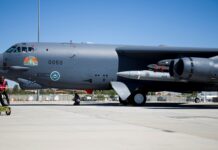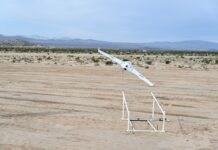
Australia Outlines Plan for Major New Defence Strategy
Peter Felstead
Australia has announced a major revamping of its defence strategy, acknowledging the need to project its military power further into the Asia-Pacific region in light of what is perceived as an increased threat from China.
Releasing a public version of the country’s Defence Strategic Review on 24 April 2023, the government of Prime Minister Anthony Albanese stated that it agrees, or agrees in principle with further work required, to the review’s recommendations. The review paves the way for an inaugural National Defence Strategy to be produced in 2024, which will be updated biennially.
The Albanese government commissioned the Defence Strategic Review in August 2022, soon after assuming office in May of that year, charging Stephen Smith, the current High Commissioner of Australia to the United Kingdom, and retired air chief marshal Sir Angus Houston to lead it.
In a statement attached to the review, Australian Deputy Prime Minister and Defence Minister Richard Marles states that Australia “has a fundamental interest in protecting our connection to the world and in the global rules-based order upon which international trade depends”. To do this he states that the ADF “must have the capacity to engage in impactful projection across the full spectrum of proportionate response” and “must be able to hold an adversary at risk further from our shore”. This being the case, Marles concurs with the finding of the review that “the ADF as currently constituted and equipped is not fully fit for purpose”.
The review itself acknowledges early on that Australia’s most significant strategic partner, the United States, “is no longer the unipolar leader of the Indo-Pacific” and that the region “has seen the return of major power strategic competition, the intensity of which should be seen as the defining feature of our region and time”.
Noting that “China’s military build-up is now the largest and most ambitious of any country since the end of the Second World War”, the review asserts that Beijing’s “assertion of sovereignty over the South China Sea threatens the global rules-based order in the Indo-Pacific in a way that adversely impacts Australia’s national interests” adding that China “is also engaged in strategic competition in Australia’s near neighbourhood”.
While emphasising that statecraft and the forging of strong regional defence partnerships will be key, the review concedes that the current ADF force structure “is based on a ‘balanced force’ model that reflects a bygone era. It does not adequately address our new strategic environment.” The review consequently asserts that the ADF “must evolve into a genuine Integrated Force which harnesses effects across all five domains: maritime, land, air, space and cyber”.
Distilling the major findings of the review, the Albanese government has identified six priority areas for immediate action, some of which are already underway:
- acquiring nuclear-powered attack submarines (SSNs) through the AUKUS Pact to improve Australia’s deterrence capabilities;
- developing the Australian Defence Force’s (ADF) ability to precisely strike targets at longer range and manufacturing the munitions for this domestically;
- improving the ADF’s ability to operate from Australia’s northern bases;
- initiatives to improve the growth and retention of a highly skilled defence workforce;
- lifting Australia’s capacity to rapidly translate disruptive new technologies into ADF capability, in close partnership with Australian industry; and
- deepening Australia’s diplomatic and defence partnerships with key partners in the Indo-Pacific.
With the review outlining an approach where the former ‘Defence of Australia’ strategy gives way to a new concept of ‘National Defence’, a significant aspect of the new approach is the ability to project Australian military power over much longer distances than previously possible.
“Australia’s immediate region encompassing the north-eastern Indian Ocean through maritime Southeast Asia into the Pacific, including our northern approaches, should be the primary area of military interest for Australia’s National Defence,” the review states. It adds that a ‘strategy of denial’ must be developed, focused on the development of anti-access/area denial capabilities, and that this will be key to the ADF being able to “deny an adversary freedom of action to militarily coerce Australia and to operate against Australia without being held at risk”.
While emphasising the importance to its new strategy of the SSNs ordered under Australia’s AUKUS Pact with the UK and US being acquired as soon as possible, the review recommends that “an independent analysis of [the Royal Australian] Navy’s surface combatant fleet capability should be conducted in Q3 2023 to ensure its size, structure and composition complement the capabilities provided by the forthcoming conventionally armed, nuclear-powered submarines. The analysis must assess: the capability requirements to meet our current strategic circumstances as outlined in the Review, as well as the cost, schedule, risks and the continuous shipbuilding potential of each option.”

The Australian Army, the reviews says, must be optimised to provide “a littoral manoeuvre capability by sea, land and air; long-range fires, including land-based maritime strike; air and missile defence; and close-combat capabilities, including a single armoured combined-arms brigade, able to meet the most demanding land challenges in our region”.
With this in mind, the review recommends the following measures:
- the army should be structured and postured in accordance with the land domain force structure design priorities outlined in the review;
- Project Land 8710 Phases 1-2, covering littoral manoeuvre vessels (medium and heavy landing craft), should be accelerated and expanded;
- Project Land 8113 Phases 2-4, covering long-range fires through acquisition of the US High-Mobility Artillery Rocket System (HIMARS), and Project Land 4100 Phase 2, covering land-based maritime strike, should be accelerated and expanded;
- Project Land 400 Phase 3, covering acquisition of the Land Combat Vehicle System (Infantry Fighting Vehicle), should be reduced from 450 to 129 vehicles to provide one mechanised battalion;
- Project Land 8116 Phase 2, covering the acquisition of a second regiment of K9 self-propelled howitzers, should be immediately cancelled;
- The delivery of landing craft, long-range fires, and infantry fighting vehicles should be synchronised.
Regarding the Royal Australian Air Force (RAAF), the review’s key recommendations are as follows:
- the RAAF must develop a plan to increase aircrew numbers to ensure that air combat and P-8 maritime patrol aircraft squadrons have the crewing to operate all available aircraft at high tempo;
- the RAAF’s F-35A Joint Strike Fighter and F/A-18F Super Hornet aircraft must be able to operate the Long-Range Anti-Ship Missile;
- the Joint Strike Missile (JSM) should also be integrated onto the F-35A, requiring the F-35 fleet to be upgraded to the Block 4 configuration;
- the MQ-28A Ghost Bat ‘loyal wingman’ unmanned combat air vehicle should be a priority for collaborative development with the US.
- acquisition of the US B-21 Raider future bomber as a potential capability option for Australia should be dropped as an unsuitable option for Australia’s strategic imperatives.
In terms of space and cyber initiatives, the review suggests the following:
- Australia’s Defence Space Command, which resides within the RAAF, needs to be repostured to maximise its effectiveness and should be moved into the Joint Capabilities Group from 1 July 2023;
- a centralised space domain capability development and management function should be established;
- a method should be established for building and sustaining a trained defence space workforce, including a defined career path for space professionals;
- a comprehensive framework should be developed for managing operations in the cyber domain that is consistent with the other domains;
- the ADF’s cyber domain capabilities should be strengthened to deliver the required breadth of capability with appropriate responsiveness to support ADF operations.
As far as timelines go, the review states that the current ‘Force-in-Being’ (the ADF that exists today) should have moved to an ‘Enhanced Force-in-Being’ by 2025, to an ‘Objective Integrated Force’ from 2026-2030 that benefits from the accelerated acquisition and delivery of identified critical capabilities, and then to the full Future Integrated Force envisioned by the review from 2031.
Peter Felstead




![The British naval construction sector: Status report Construction of SSN-AUKUS submarines will support the UK’s submarine industrial base for decades ahead. [Crown Copyright 2024]](https://euro-sd.com/wp-content/uploads/2025/09/4_SSN-AUKUS-Kopie-218x150.jpg)







